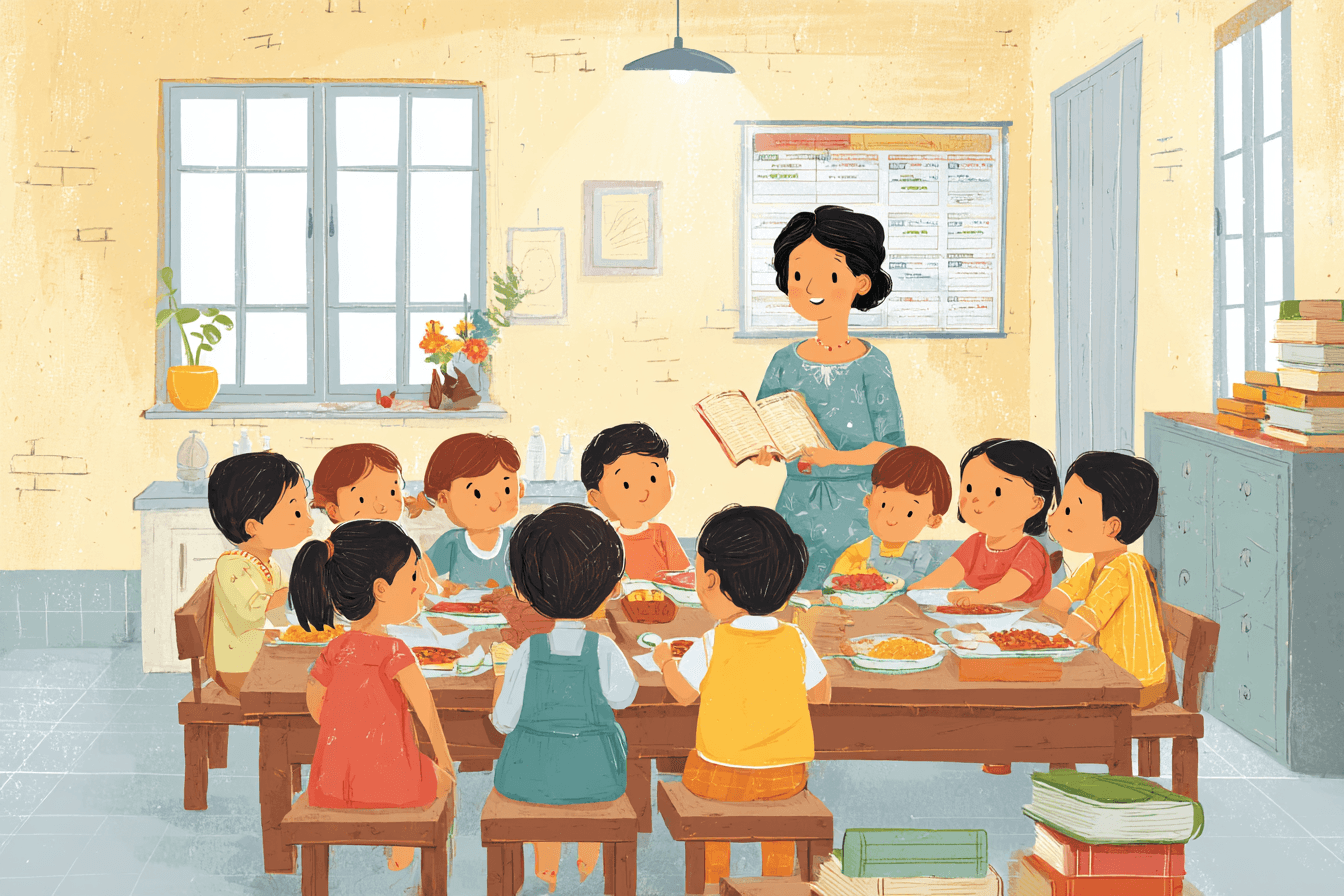Table Manners for Kids | A Complete Guide for Parents
Last Updated At: 25 Jul 2025
13 min read

Table of Contents
- Why Are Table Manners Important for Kids?
- When Should You Start Teaching Table Manners?
- Basic Table Manners Every Child Should Know
- Making Table Manners Fun for Kids
- How to Reinforce Good Table Manners at Home
- Teaching Table Manners in Different Settings
- Common Challenges and How to Overcome Them
- Sample Table Manners Routine for Kids
- Real-Life Benefits of Teaching Table Manners
- Why Choose PlanetSpark for Table Manners and Etiquette Train
- Final Thoughts: A Lifelong Gift
- FAQs: Table Manners for Kids
Teaching table manners to kids is more than just getting them to eat without spilling food. It’s about helping them develop lifelong habits of respect, patience, and social grace, skills they’ll carry into classrooms, friendships, family dinners, and even future careers.
In this guide, we’ll explore why table manners matter, what age-appropriate etiquette looks like, and how parents can make learning fun and stress-free at home. Let’s raise polite little diners, one meal at a time.
Why Are Table Manners Important for Kids?
While table manners may seem old-fashioned in today’s fast-paced world, they play a crucial role in your child’s social development. Good table manners teach respect for others’ time, food, and space. They help children practice patience by waiting their turn, eating calmly, and not interrupting. These habits also promote cleanliness, hygiene, and discipline, making meals a more pleasant experience for everyone.
More importantly, manners build confidence. A child who knows how to behave at a dining table will feel more comfortable in unfamiliar social situations, whether it’s eating at a restaurant, attending a school event, or visiting a friend’s house. The simple act of saying “please” and “thank you” helps children express gratitude and grow into thoughtful, respectful individuals.
Want to boost your child’s social skills beyond the dining table?
Try PlanetSpark’s Personality Development Classes that cover etiquette, confidence-building, and more.

When Should You Start Teaching Table Manners?
Many parents wonder: Is my child too young to learn table manners? The truth is, you can begin as early as toddlerhood around the time your child starts eating solid foods and sitting with the family at the table. In fact, the earlier you introduce basic etiquette, the easier it becomes for children to adopt these behaviors as second nature.
Children as young as 18 months to 2 years are incredibly observant. They mimic adult behaviors, follow routines, and enjoy copying what they see. That makes this age a great time to start teaching simple table expectations like sitting at the table, using a spoon, and saying “thank you.” You don’t need to expect perfect behavior instead, focus on modeling and consistency. At this stage, it’s all about laying the foundation.
As your child grows, you can gradually introduce more complex habits. By age 4 or 5, most children can start using a fork, wiping their mouths with a napkin, and learning to wait until everyone is served. At this point, they are also capable of understanding social cues and cause-effect relationships, which helps in reinforcing polite behavior at the table.
By the time children reach ages 6 to 8, they are ready for more structured lessons in etiquette such as how to pass food politely, engage in respectful mealtime conversation, and manage their cutlery more confidently. This is also a great time to start preparing them for eating in public settings like restaurants or at a friend’s house.
Older children, particularly those between 9 and 12, can handle more nuanced table behavior such as using a knife properly, placing napkins on their laps, and understanding cultural dining practices or guest etiquette. This is also the age where kids are likely to attend school events, birthday parties, and social gatherings, so reinforcing good manners can help boost their confidence and social acceptance.
The key is to make table manners a gradual, age-appropriate journey not a strict list of rules to memorize. Each child will progress at their own pace, but with consistency, praise, and patience, these skills become lifelong habits.
Remember, children learn best by observing and doing. Invite them to eat with the family, model respectful behavior, and offer gentle reminders when needed. Even brief five-minute dinner conversations can be rich with teachable moments that shape how they behave at the table now and in the future.

Basic Table Manners Every Child Should Know
Here’s a checklist of essential manners every child can master:
Wash Your Hands Before Eating
Explain the importance of hygiene. Make it a ritual to go wash up before every meal.
Wait Until Everyone Is Seated
Teach kids to respect group dynamics by waiting until everyone is seated (and food is served) before starting to eat.
Use Cutlery Correctly
Introduce spoon, fork, and later knife usage at an age-appropriate pace. Show them how to hold utensils, and correct gently when they switch hands or play with them. The best way to teach this is to model the behavior during family meals.
Struggling to get your child to use cutlery properly?
Explore PlanetSpark’s Etiquette and Communication Classes to make learning fun.
Chew With Your Mouth Closed
One of the golden rules, remind them it’s respectful and hygienic.
No Talking With Food in Mouth
Help children understand why it looks and sounds unpleasant. Encourage them to finish chewing before speaking.
Use a Napkin, Not Your Sleeve
Give them cloth or paper napkins and show how to dab their mouths instead of wiping with hands.
Say “Please,” “Thank You,” and “Excuse Me”
Teach these magic words during mealtime interactions. Practice requesting food politely, thanking for meals, and asking to leave the table.
Avoid Negative Comments About Food
Even if they dislike something, guide them to express it kindly. For example, instead of saying “I don’t like this,” encourage phrases like “I’d prefer something else, please.”
Clean Up After Eating
Encourage clearing their own plate, disposing of leftovers properly, and helping with basic clean-up.
Making Table Manners Fun for Kids
Children learn best when they’re having fun. Here are some creative, engaging ways to make table manners exciting instead of exhausting.
Turn It Into a Game
Use “Manner Bingo” with behaviors like chewed with mouth closed or used napkin. Or create a “Manners Star Chart” to reward consistent good behavior with stars and small treats.
Role Play Restaurant Scenarios
Pretend your dining room is a restaurant. Let kids play the waiter, customer, or host. Practice ordering food, waiting, and using polite conversation.
Use Storytelling and Books
There are several picture books and stories around table manners. Some popular ones include “How Do Dinosaurs Eat Their Food?” by Jane Yolen and “Please, Mr. Panda” by Steve Antony.
Looking to improve your child’s reading, communication, and expression skills too?
Join PlanetSpark’s Creative Writing and Reading Comprehension Classes for kids.
How to Reinforce Good Table Manners at Home

Helping your child develop good table manners isn't a one-time lesson, it’s a gradual process built through repetition, observation, and positive reinforcement. Your home is the best place to build these habits, as children feel safe and learn most from the environment they grow up in. Here are some structured ways to effectively reinforce table manners at home:
1. Lead by Example
Children are natural imitators. They observe everything the adults around them do especially their parents. If you model calm, respectful, and polite behavior at the dining table, your child will absorb those habits without even realizing it.
Sit down together as a family whenever possible. Avoid rushing through meals or eating on the go. Make a point of placing your napkin on your lap, chewing with your mouth closed, using polite phrases like “please” and “thank you,” and engaging in respectful conversation. These small actions set a silent but powerful standard for your child to follow.
2. Set Clear and Consistent Mealtime Rules
Consistency helps children understand what is expected of them. Establish a few age-appropriate dining rules and ensure they’re followed every day. Keep these rules short, simple, and easy to remember.
Common examples of effective mealtime rules include:
No devices at the table (phones, TV, or tablets)
Sit properly until everyone is finished
Use utensils instead of hands, where appropriate
Say “please” when requesting food and “thank you” after
Do not interrupt others while they’re speaking
It can be helpful to write these rules down or create a small “Mealtime Manners” poster to hang near your dining area.
3. Use Gentle Corrections and Reminders
Mistakes are part of learning. When your child forgets a rule or slips up, gently correct them without shaming or scolding. Remember, the goal is not perfection but progress through encouragement.
Instead of saying, “Stop doing that,” try redirecting with calm phrases like:
“Let’s remember to chew with our mouths closed.”
“Oops! Can you place your napkin on your lap like we practiced?”
“Please wait until your sister is done talking. That’s polite.”
This respectful approach helps preserve your child’s self-esteem while teaching them the correct behavior in a nurturing way.
4. Create a Positive and Engaging Mealtime Environment
Reinforcing manners should never make mealtime feel rigid or stressful. In fact, it’s easier for children to follow etiquette when they associate it with enjoyable family time.
Turn off distractions and use meals as an opportunity to talk, laugh, and connect as a family. Ask open-ended questions like:
“What was the best part of your day?”
“If you could cook dinner tomorrow, what would you make?”
This fosters social conversation skills while also reinforcing calm behavior and polite speaking habits.
5. Praise Good Behavior Immediately
Positive reinforcement is incredibly effective. When your child demonstrates good manners, no matter how small, acknowledge it right away. This immediate recognition creates a sense of pride and motivation to repeat the behavior.
Instead of vague praise like “Good job,” be specific:
“I loved how you passed the bowl without reaching across the table. That was very polite.”
“You waited patiently for everyone to be seated, great manners!”
Consistent praise boosts your child’s self-confidence and helps them form lasting habits rooted in kindness and consideration.
6. Make It a Daily Habit, Not a One-Time Lesson
Just like brushing teeth or packing a school bag, table manners need daily practice. It’s through repetition that children start to internalize these behaviors as natural parts of their routine.
Even if it’s just one meal a day where the whole family eats together, use that time intentionally. Highlight one or two manners you want to reinforce, and focus on those consistently for a few weeks before introducing new ones. Over time, these small efforts add up and create a long-term impact.
7. Involve Children in Mealtime Responsibilities
Another great way to reinforce etiquette is by involving children in setting the table, serving food, or clearing their own plates. This builds a sense of responsibility and helps them understand that meals are a shared experience, not just about individual eating.
You can even assign small rotating duties:
One child places napkins
Another arranges cutlery
Someone else helps wipe the table after dinner
These rituals not only teach responsibility but also improve their appreciation for order, cleanliness, and teamwork.
Want Your Child to Shine in Every Social Setting?
Good table manners are just one piece of the puzzle. To help your child truly grow into a confident, respectful communicator, at the dining table, school, and beyond, you need a structured, expert-led approach.
Book a free demo class with PlanetSpark and let your child begin their journey toward lifelong etiquette, confidence, and public presence.
Teaching Table Manners in Different Settings
Kids should understand that etiquette may vary slightly in different scenarios. At home, keep the atmosphere relaxed but consistent. It’s your best opportunity to practice new skills daily. In a restaurant, teach them to order politely, use a softer voice, and keep their area clean. Prepare them before you go and praise them afterward.
When visiting a friend’s house, remind them to respect the host’s rules, say thank you for the meal, and avoid making rude comments about the food. These settings reinforce what they’ve learned and give them confidence to adapt across different environments.
Equip your child to thrive in social situations.
Discover PlanetSpark’s Public Speaking and Social Etiquette Classes for well-rounded learning.
Give your child a head start in personality development with PlanetSpark’s etiquette and table manners training. 👉 Book a FREE Demo Class and build the foundation of lifelong confidence today!
Common Challenges and How to Overcome Them
Picky eating is one of the most common issues. Instead of forcing or bribing, involve your child in meal planning and preparation. Give them choices within boundaries. For instance, ask, “Would you prefer rice or roti?” rather than asking open-ended questions.
Children often default to using hands instead of cutlery, especially if they’re used to traditional Indian meals. While it’s acceptable in many homes, you can gently introduce cutlery for certain meals and model the usage in a fun, relaxed way.
Restlessness during meals can be managed by limiting distractions, reducing meal duration, and initiating light, engaging conversation. Turn off screens, keep mealtimes tech-free, and focus on making it a family bonding moment.
Keep meals tech-free and family-focused. Conversation improves both manners and language development.
Sample Table Manners Routine for Kids
Here’s a simple daily routine you can adapt:
Wash hands before meals
Sit down at the table with a calm body
Wait for everyone to be seated
Use napkin on lap and proper cutlery
Eat slowly, chew properly, no talking with mouth full
Say “please” and “thank you” during meal
Clear your plate after finishing
Thank the person who cooked the meal
Repeat this consistently and reinforce with positive words.

Real-Life Benefits of Teaching Table Manners
Kids who master table manners are more confident at birthday parties, school picnics, or outings. They build stronger peer relationships through respectful interaction. It opens doors to public speaking, leadership, and hosting skills, and encourages mindfulness, gratitude, and discipline.
Why Choose PlanetSpark for Table Manners and Etiquette Training?
1:1 Expert Sessions – Personalised coaching from certified trainers
Interactive Learning – Role plays, dining setups, and real-life scenarios
Beyond Manners – Builds confidence, communication, and social skills
Parent Updates – Regular PTMs and detailed progress reports
Age-Appropriate Curriculum – Lessons designed for different age groups from 4 to 14 years
Gamified Practice – Fun quizzes and activities to make learning stick
Real-Life Application – Encourages kids to apply table manners in daily routines
Final Thoughts: A Lifelong Gift
Table manners go far beyond forks and napkins. They nurture empathy, communication, and composure values that shape future leaders. Start early, stay patient, and celebrate small wins.
Help your child master table manners, etiquette, and confidence.
Book a FREE demo class with PlanetSpark today!
FAQs: Table Manners for Kids
Q1. At what age should I start teaching table manners?
Start as early as 2 years with basic instructions like sitting at the table and saying “thank you.”
Q2. What if my child refuses to follow manners?
Stay consistent, lead by example, and use positive reinforcement instead of punishment.
Q3. Should I expect perfect behavior at restaurants?
No, aim for progress, not perfection. Brief them before outings and praise good behavior afterward.
Q4. Do manners help with school interviews or public speaking?
Absolutely. Respectful kids are more confident, attentive, and better communicators.
Personalized Communication Report
Record a video to get a AI generated personalized communication report for your child
Select Learner's Class

Hi There, want to try these
tips for your child with
LIVE with our expert coach?
Let's check your child's
English fluency
